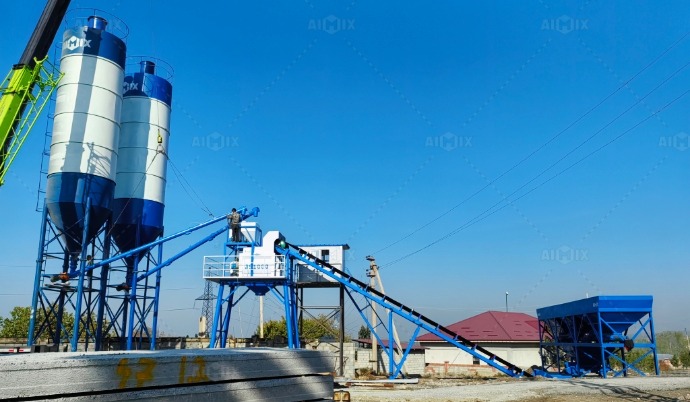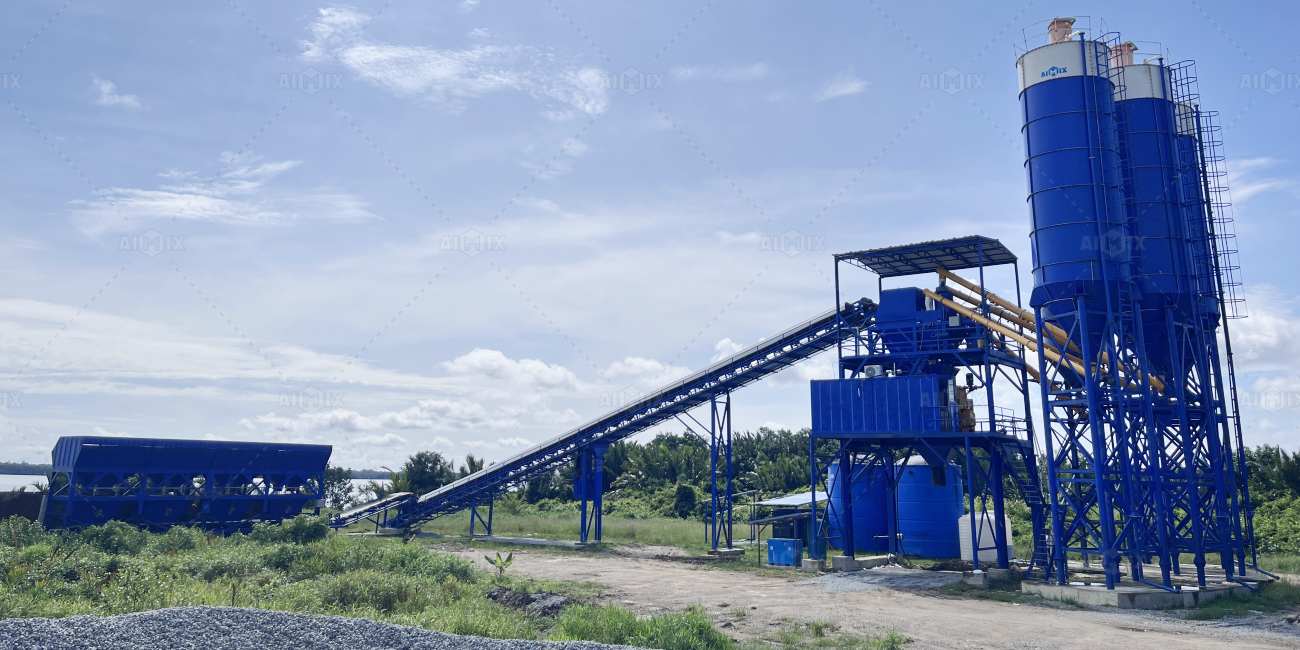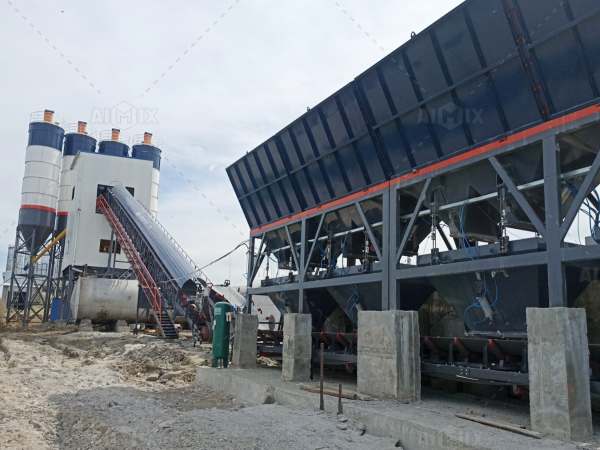In the world of construction, the need for reliable, consistent, and high-quality concrete is paramount. A concrete plant plays a crucial role in ensuring that projects are completed on time and to the necessary specifications. But what is a concrete plant, and how does it optimize construction efficiency? This article will answer those questions by explaining the different types of concrete plants, such as the mobile concrete batching plant, stationary batching plant, and ready mix concrete batching plant, and how they contribute to smooth operations on construction sites.
What Is a Concrete Plant?
A concrete plant is a facility used to produce concrete. It consists of various equipment and machinery designed to combine cement, aggregates (sand, gravel, or crushed stone), water, and sometimes additives to create concrete. Concrete plants are often categorized based on their configuration, mobility, and production capacity.
Concrete plants are a vital part of the construction process, particularly for large-scale projects like highways, bridges, buildings, and other infrastructure. They ensure that the right amount of concrete is mixed to precise specifications, improving the quality of the finished product and meeting the demanding schedules of modern construction projects.

Types of Concrete Plants
There are several types of concrete plants used in the construction industry, each offering specific advantages depending on the needs of the project. The most common types include the mobile concrete batching plant, stationary batching plant, and ready mix concrete batching plant.
1. Mobile Concrete Batching Plant
A mobile concrete batching plant is a portable and compact facility that can be easily transported to different job sites. Unlike stationary plants, which are fixed in place, mobile plants can be moved as needed, making them ideal for projects that require frequent changes in location or are situated in remote areas.
One of the key advantages of a mobile concrete batching plant is its flexibility. Contractors can move the plant from one site to another, making it an excellent choice for construction projects that span multiple locations or are of a temporary nature. For example, roadwork, bridge construction, or projects in hard-to-reach areas can benefit from the mobility of these plants.
Mobile concrete batching plants typically come with all the necessary equipment and controls for concrete production, including a cement silo, aggregate bins, water supply systems, and mixers. They are designed to be easily set up and can be operational within a short period. This eliminates the need for transporting large volumes of concrete over long distances, saving time and reducing costs associated with logistics.
2. Stationary Batching Plant
A stationary batching plant is a fixed facility used for high-volume concrete production. These plants are typically used for large-scale construction projects that require continuous and high-quality concrete production. Stationary batching plants are ideal for projects where the construction site is permanent or located in areas with easy access to materials and transportation routes.
Stationary batching plants have larger production capacities compared to mobile plants and are capable of producing concrete at a consistent and high rate. These plants are often equipped with advanced automation systems that control the entire batching process, including weighing, mixing, and delivery of materials. This allows for precise control over the concrete’s composition, which is essential for ensuring that the concrete meets specific strength, durability, and workability requirements.
The downside of stationary batching plants is their lack of mobility. Once set up, they are meant to stay in place for the duration of the project, which makes them less suitable for projects requiring frequent relocation. However, their larger capacity and ability to produce high-quality concrete consistently make them a top choice for large-scale developments.

3. Ready Mix Concrete Batching Plant
A ready mix concrete batching plant is a type of plant that produces concrete in large quantities and delivers it directly to construction sites. Unlike the other types of concrete plants, which are used primarily for on-site mixing, ready mix plants produce concrete off-site and transport it to the project location via concrete trucks or mixers.
Ready mix concrete plants are highly efficient and can deliver large volumes of concrete quickly and consistently. They are often used in projects where large amounts of concrete are required within a short period, such as commercial buildings, highways, and industrial projects. By batching and mixing the concrete off-site, ready mix plants reduce the risk of errors and inconsistencies in the mix, ensuring that the concrete delivered to the site is of the highest quality.
The major advantage of ready mix concrete batching plants is the convenience they offer. Since the concrete is mixed in advance, construction workers on-site do not need to spend time and effort batching and mixing concrete themselves. This reduces the overall labor required on the site and speeds up the construction process. Moreover, the concrete is transported in mixer trucks, ensuring it remains in good condition until it reaches the site.
4. Comparison of Mobile, Stationary, and Ready Mix Concrete Plants
While all three types of concrete plants are used to produce high-quality concrete, they differ in terms of flexibility, production capacity, and application.
-
Mobile Concrete Batching Plant: Ideal for projects that require flexibility and portability. These plants are perfect for construction sites that move frequently, such as road or bridge projects. Their compact size and ability to be set up quickly make them a popular choice for small-to-medium-sized projects.
-
Stationary Batching Plant: Best suited for large-scale projects that require continuous and high-volume production of concrete. Stationary plants are highly efficient and capable of delivering consistent and precise concrete mixes. However, they are not portable and are generally used for long-term, large-scale construction.
-
Ready Mix Concrete Batching Plant: Excellent for large projects that require large quantities of concrete. Ready mix plants provide convenience by delivering pre-mixed concrete directly to construction sites, ensuring high-quality, ready-to-use concrete when needed. This type of plant is often used in commercial, industrial, and infrastructure projects.

How Concrete Plants Optimize Construction Efficiency
Concrete plants play an integral role in optimizing construction efficiency by improving the speed and accuracy of concrete production. Here’s how:
1. Reduced Construction Time
Using a concrete plant allows for the continuous supply of high-quality concrete without delays. Mobile batching plants enable construction projects to maintain progress even in remote locations, while ready mix plants eliminate on-site mixing time. Stationary batching plants offer a steady, high-volume supply of concrete, reducing the time spent waiting for concrete delivery.
2. Minimized Waste and Costs
By using automated systems to control the ingredients of the concrete mix, concrete plants ensure that only the required amount of materials is used. This reduces waste, which can lead to significant savings in material costs. Additionally, the use of ready mix plants eliminates the risk of over-ordering or under-ordering concrete, as the precise amount of concrete required can be calculated in advance.
3. Enhanced Quality Control
Concrete plants, especially stationary ones, provide a high level of control over the composition of the concrete mix. Automated systems ensure that materials are mixed in the correct proportions, reducing the risk of errors and inconsistencies. This leads to a more durable and high-strength final product, which is essential for the structural integrity of the construction.
4. Efficient Logistics
Concrete plants, particularly mobile and ready mix types, simplify the logistics of concrete delivery. Ready mix plants use concrete trucks that transport the mix directly to the site, reducing the need for manual labor. Mobile batching plants reduce the time spent transporting concrete from off-site plants and ensure that mixing is done close to the job site, reducing delivery time and potential delays.
Conclusion
A concrete plant is a vital facility in modern construction, providing essential support in producing high-quality concrete efficiently. Whether it’s a mobile concrete batching plant, stationary batching plant, or ready mix concrete batching plant, each type plays a key role in optimizing construction productivity by improving logistics, reducing waste, and ensuring concrete quality. By selecting the right concrete plant based on the project’s size, location, and requirements, construction teams can streamline their operations, save time and money, and ensure the successful completion of projects.